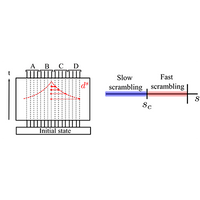Onset of Scrambling as a Dynamical Transition in Tunable-Range Quantum Circuits
IF 11
Q1 PHYSICS, APPLIED
引用次数: 0
Abstract
In a fast scrambling many-body quantum system, information is spread and entanglement is built up on a timescale that grows logarithmically with the system size. This is of fundamental interest in understanding the dynamics of many-body systems, as well as in efficiently producing entangled resource states and error-correcting codes. In this work, we identify a dynamical transition marking the onset of scrambling in quantum circuits with different levels of long-range connectivity. In particular, we show that as a function of the interaction range for circuits of different structures, the tripartite mutual information exhibits a scaling collapse around a critical point between two clearly defined regimes of different dynamical behaviour. We study this transition analytically in a related long-range Brownian circuit model and show how the transition can be mapped onto the statistical mechanics of a long-range Ising model in a particular region of parameter space. This mapping predicts mean-field critical exponents $\nu = -1/(1+s_c)$, which are consistent with the critical exponents extracted from Clifford circuit numerics. In addition to systems with conventional power-law interactions, we identify the same phenomenon in deterministic, sparse circuits that can be realised in experiments with neutral atom arrays.

可调范围量子电路中置乱起始的动态跃迁
在一个快速扰频的多体量子系统中,信息被传播,纠缠在一个随系统大小呈对数增长的时间尺度上建立。这对于理解多体系统的动力学,以及有效产生纠缠资源状态和纠错码具有根本意义。在这项工作中,我们确定了一个动态跃迁,标志着具有不同长程连接水平的量子电路中扰频的开始。特别地,我们表明,作为不同结构电路相互作用范围的函数,三方互信息在两个明确定义的不同动力学行为状态之间的临界点附近表现出标度坍塌。我们在相关的长程布朗回路模型中分析地研究了这种跃迁,并展示了如何在参数空间的特定区域中将这种跃迁映射到长程伊辛模型的统计力学上。该映射预测平均场临界指数$\nu=-1/(1+s_c)$,这与从Clifford电路数值中提取的临界指数一致。除了具有传统幂律相互作用的系统外,我们在确定性稀疏电路中发现了同样的现象,这可以在中性原子阵列的实验中实现。
本文章由计算机程序翻译,如有差异,请以英文原文为准。
求助全文
约1分钟内获得全文
求助全文

 求助内容:
求助内容: 应助结果提醒方式:
应助结果提醒方式:


